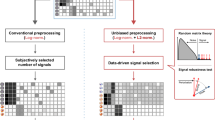Abstract
Cancer is, at the cellular level, a genetic disease and acquired gene fusions play a causal role in the initiation of the neoplastic process either by activating proto-oncogenes or creating hybrid genes. We constructed a network by combining the 5′ and 3′ parts of all presently known gene fusions in human neoplasia and here we show that the observed network is fragmented and that the organization of the genes demonstrates a scale-free network topology with a power law degree distribution meeting the requirements of P(k)∼k-γ, that is, conforming to the distributions found in naturally occurring networks such as the Internet and social or ecological networks. The results hence indicate that the complex system of pairwise interacting genes leading to neoplasia is governed by a universal principle.
This is a preview of subscription content, access via your institution
Access options
Subscribe to this journal
Receive 50 print issues and online access
$259.00 per year
only $5.18 per issue
Buy this article
- Purchase on Springer Link
- Instant access to full article PDF
Prices may be subject to local taxes which are calculated during checkout


Similar content being viewed by others
References
Albert R, Barabási AL . (2002). Rev Mod Phys 74: 47–97.
Albert R, Jeong H, Barabási AL . (2000). Nature 406: 378–782.
Apic G, Gough J, Teichmann SA . (2001). Bioinformatics 17 (Suppl 1): S83–S89.
Barabási AL, Albert R . (1999). Science 286: 509–512.
Barabási AL, Oltvai ZN . (2004). Nat Rev Genet 5: 101–113.
Callaway D, Hopcroft JE, Kleinberg JM, Newman ME, Strogatz SH . (2001). Phys Rev E 64: 041902–041908.
Collins EC, Rabbitts TH . (2002). Trends Mol Med 8: 436–441.
Davidson AC, Hinkley DV . (1997). Bootstrap Methods and Their Applications. Cambridge University Press: Cambridge.
Erdös P, Rényi A . (1960). Publ Math Inst Hung Acad Sci 5: 17–60.
Holme P, Liljeros F, Edling CR, Kim BJ . (2003). Phys Rev E 68: 056107.
Johnson NL, Kotz S, Kemp AW . (1992). Univariate Discrete Distribution. John Wiley and Sons: New York.
Klemm K, Eguiluz VM . (2002). Phys Rev E 65: 036123–036127.
Liljeros F, Edling CR, Amaral LA, Stanley E, Åberg Y . (2001). Nature 411: 907–908.
Middendorf M, Ziv E, Wiggins CH . (2005). Proc Natl Acad Sci USA 102: 3192–3197.
Mitelman F, Johansson B, Mertens F . (2004). Nat Genet 36: 331–334.
Vazquez A, Flammini A, Maritan A, Vespignani A . (2003). ComPlexUs 1: 38–44.
Vogelstein B, Kinzler KW . (2004). Nat Med 10: 789–799.
Watts DS, Strogatz H . (1998). Nature 393: 440–442.
Wuchty S . (2001). Mol Biol Evol 18: 1694–1702.
Wylie JL, Jolly A . (2001). Sex Transm Dis 28: 14–24.
Acknowledgements
We thank Nils Mandahl and Anders Rydholm for helpful comments. This work was supported by the Swedish Cancer Society and the Swedish Children's Cancer Foundation.
Author information
Authors and Affiliations
Corresponding author
Rights and permissions
About this article
Cite this article
Höglund, M., Frigyesi, A. & Mitelman, F. A gene fusion network in human neoplasia. Oncogene 25, 2674–2678 (2006). https://doi.org/10.1038/sj.onc.1209290
Received:
Revised:
Accepted:
Published:
Issue Date:
DOI: https://doi.org/10.1038/sj.onc.1209290
Keywords
This article is cited by
-
Applications of dual regularized Laplacian matrix for community detection
Advances in Data Analysis and Classification (2023)
-
Network analysis of gene fusions in human cancer
BMC Bioinformatics (2013)
-
TICdb: a collection of gene-mapped translocation breakpoints in cancer
BMC Genomics (2007)



